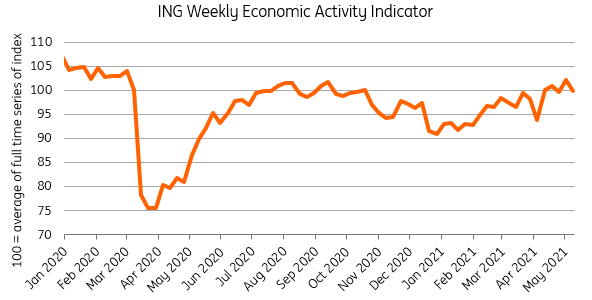Wednesday, May 26, 2021 11:33 AM EST
The ING Weekly Economic Activity Indicator (WAI has returned to levels last seen in the summer of 2020. This confirms expectations of a strong rebound upon reopening of economies and shows upside potential to our current 1.4% quarter-on-quarter GDP growth forecast for 2Q.

Our nowcast index has been trending upwards for quite some time now. In the week ending 8 May, the index reached 102.1, which was the highest reading since early March 2020, so around the start of the pandemic in Europe. It dropped slightly to 99.8 in the week after but remains at levels last seen before the second wave.
The turning point already occurred in January after which activity has steadily been on the rise. It is quite remarkable that this has happened despite a lack of substantial easings in Covid-19 restrictions in the months leading up to May. As vaccination programs have picked up speed and more easings are expected, there is further upside to the indicator and to our forecast for second-quarter GDP.
Looking at the variables comprising the index, we see that Google searches for unemployment and benefits have fallen back to the pre-pandemic trend. That indicates that the labor market is improving and that confidence in maintaining employment is rising among people in the eurozone. Electricity use has increased significantly over the first few months of the year, while NO2 emissions remaining below pre-pandemic levels.
Mobility data shows that daily trips to retail and recreation sites has increased quickly in the past four weeks as restrictions eased, and the number of visits to workplaces has reached the highest level since October. The number of trips to essential retail like supermarkets has already surpassed pre-pandemic levels.
The ING WAI has increased to levels last seen before the second wave

Source: ING Research
In a crisis that is evolving more by the day than by the quarter, economists have been scrambling to make sense of economic activity with more than the usual monthly or quarterly data sources. As a snapshot indicator, we combine high-frequency indicators into a weekly activity index for the eurozone and follow the example of several national central banks, which have come up with similar indicators in recent months. This indicator is, in our view, particularly useful for the coronavirus crisis as it is designed to detect bigger swings more than small differences in growth rates. For more on the methodology, click here.
Disclaimer: This publication has been prepared by the Economic and Financial Analysis Division of ING Bank N.V. (“ING”) solely for information purposes without regard to any ...
more
Disclaimer: This publication has been prepared by the Economic and Financial Analysis Division of ING Bank N.V. (“ING”) solely for information purposes without regard to any particular user's investment objectives, financial situation, or means. ING forms part of ING Group (being for this purpose ING Group NV and its subsidiary and affiliated companies). The information in the publication is not an investment recommendation and it is not investment, legal or tax advice or an offer or solicitation to purchase or sell any financial instrument. Reasonable care has been taken to ensure that this publication is not untrue or misleading when published, but ING does not represent that it is accurate or complete. ING does not accept any liability for any direct, indirect or consequential loss arising from any use of this publication. Unless otherwise stated, any views, forecasts, or estimates are solely those of the author(s), as of the date of the publication and are subject to change without notice.
The distribution of this publication may be restricted by law or regulation in different jurisdictions and persons into whose possession this publication comes should inform themselves about, and observe, such restrictions.
Copyright and database rights protection exists in this report and it may not be reproduced, distributed or published by any person for any purpose without the prior express consent of ING. All rights are reserved. ING Bank N.V. is authorised by the Dutch Central Bank and supervised by the European Central Bank (ECB), the Dutch Central Bank (DNB) and the Dutch Authority for the Financial Markets (AFM). ING Bank N.V. is incorporated in the Netherlands (Trade Register no. 33031431 Amsterdam). In the United Kingdom this information is approved and/or communicated by ING Bank N.V., London Branch. ING Bank N.V., London Branch is deemed authorised by the Prudential Regulation Authority and is subject to regulation by the Financial Conduct Authority and limited regulation by the Prudential Regulation Authority. The nature and extent of consumer protections may differ from those for firms based in the UK. Details of the Temporary Permissions Regime, which allows EEA-based firms to operate in the UK for a limited period while seeking full authorisation, are available on the Financial Conduct Authority’s website.. ING Bank N.V., London branch is registered in England (Registration number BR000341) at 8-10 Moorgate, London EC2 6DA. For US Investors: Any person wishing to discuss this report or effect transactions in any security discussed herein should contact ING Financial Markets LLC, which is a member of the NYSE, FINRA and SIPC and part of ING, and which has accepted responsibility for the distribution of this report in the United States under applicable requirements.
less
How did you like this article? Let us know so we can better customize your reading experience.




